Maui Jim Sunglasses. Risk free prescription trial
Maui Jim sunglasses are famous for their patented colour-boosting polarised sunglasses. Despite a lot of cheaper products available in the marketplace for protection and performance, these are the quality option to reduce glare and harmful UV.
We now have Maui Jim Australia, but they were developed in the early 1980s for eye protection against harmful UV and the bright direct sunlight from the cruel sun as it is known in Maui, Hawaii. Glare washes out colour and obscures detail, but the genuine Maui Jim lens boosts colours, clarity and details and improves depth perception.
The lens is optically correct, distortion-free and resists water and oils through its coatings.
They are even available for progressive lens wearers and bifocal wearers in this famous brand producing their frames and lenses. Maui Jim sunglasses use revolutionary lens materials that feature patented multi-layer technology that eliminates glare, as well as its 100% effective UV filter for harmful UV rays, enhancing colours for the human eye and making the colours pop.
Patented polarizedplus2 lens technology enhances colour and blocks glare offering UV/HEV Protection by blocking 95 to 97% of hazardous HEV light
and 100% of UVA, UVB & UVC rays according to Standards Australia/Standards New Zealand (as nzs)


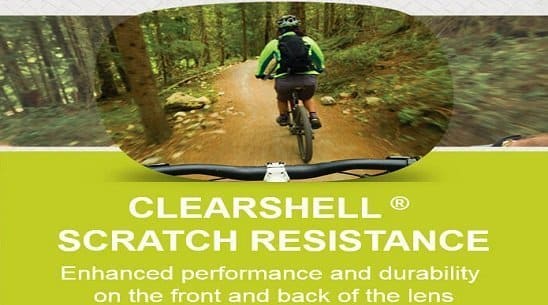
Protects from water and fingerprint oils making it easier to keep the lenses clean.
The density of the mirror coating influences transmission
Clearshell treatment preserves the patented colour enhancing layers of three rare earth elements neodymium, erbium, praseodymium that boost primary colours
The back surface anti reflection coating causing less reflection as glare to the eye and more pass-through of the incident light from the object viewed for better contrast.
The front surface mirror coating reflect light away from the eye (beyond the standard absorption of a tinted lens) which is ideal for people who are light-sensitive.
The single Gradient is a stylish alternative to the Bi-Gradient mirror. A darker application to reduce light from above and gradually gets lighter moving down the lens
The original Bi-Gradient mirror is a subtle mirror applied to the top and bottom of the lens. The mirror effectively squints for you,instead of you squinting and straining to reduce to reduce the brightest light from above and below. There is strip in the middle that will not be covered by a mirror . The silver of the mirror can be identified by holding the lens up to a white surface. That mirror colour helps to accent the lens colour.
Fashion Polarised mirrored lens option
The Blue Hawaii blue mirror coating is placed on the Neutral Grey lens, and the Sunrise pink mirror coating is on the Rose coloured lens.
Why coatings ? How are coatings different ?
The refractive index of various lens materials will affect how much light is lost to surface reflection as found using the Fresnel reflection factor formula. AR layers need to satisfy the Path condition and the Amplitude condition.
The amplitude condition for AR layers requires there to be a relationship between refractive index of the lens material and the antireflective coating. Always made ¼ the wavelength thickness for the path condition.
Single layer AR only uses magnesium fluoride whereas multicoat MAR adds zirconium fluoride and cerium trifluoride to the AR layers of the coating stack. The stack also has hydrophobic, some have oleophobic coatings as well as an adhesion layer and hardcoat.
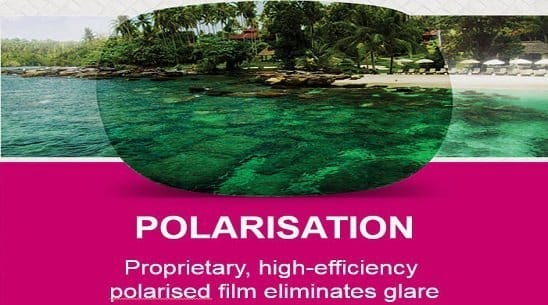
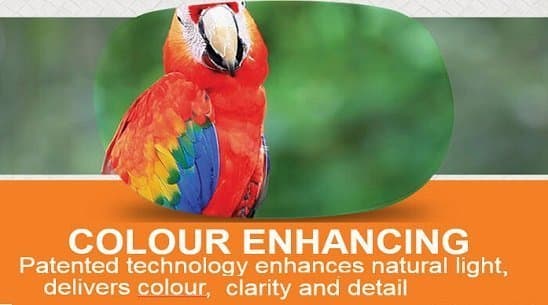
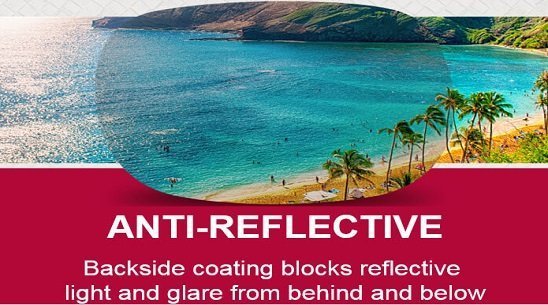
The vertical polarisation of the lenses means the disabling horizontal reflections are not visible with polarised lenses. Polarised products block out horizontal reflections!
The advantage of wearing polarised lenses outweighs the difficulty of seeing polarised LCD panels depending on their polarisation angle from their screen or windscreen reflection. Unlike some earlier displays, cars with the latest heads up displays work well with Polarised lenses. ( as have polarisation along the 45-degree line so that the wearing of polarised lenses won’t impact them)
The most common polarizers consist of iodine crystals embedded in a polymer. The polymer film is stretched (dichroism), which causes the molecules to align. Then the film is dipped in an iodine solution, and the iodine molecules attach themselves to the polymer. There are other methods like imbibed coatings, such as transitions uses that are much less efficient. The film will have colour due to the iodine crystals: the more crystals, the more efficient and the darker the lens. Lighter or high transmission polarizers, when cross-hatched, show their lack of efficiency.
Cheaper polarized glasses usually have one thin laminated filter on one side of the lens (prone to abrasion and scratching), which may only provide a small amount of benefit. Lens aberrations and crazing can occur in lower quality lenses.
Maui’s famous quality Polarized lens glasses have the film laminated between two layers of lens material, like a sandwich. This way of encasing the polarized laminate filter helps protects it from being scratched and eliminates its peeling. The thicker polarising film and its quality determine how protective the lens is against glare.
The difference over ordinary polarised types is that the extraordinary polarising film PolarisedPlus2 is sandwiched among nine layers. Incorporating surface treatments such as the famous Bi-Gradient mirror, waterproof coating, and an anti-reflective treatment reducing glare from above, behind and below, while providing unmatched comfort, clarity and protection. The concept of polarising light by the artificial film was developed by Edwin Land, the inventor of Polaroid instant photography.
The polarised lens (“Venetian blind like”) is orientated so that light rays in the vertical meridian (reflections coming from horizontal surfaces) are blocked. The sunglass wearer’s primary concern is with horizontally reflected glare. Horizontal glare comes from sunlight reflecting off surfaces, including water, roads, snow and car hoods.
And the amazing 3 rare earth elements :
- Neodymium a silvery metal
- The oxide erbia being a pink colouring agent in glazes and glasses.
- Praseodymium salts can colour glasses and enamels.
By being infused into the lens, they work by eliminating orange, violet, and other colours’ wavelength so that colours’ pop’ – where the blues, greens and reds- are more authentic & brighter. An analogy could be noise-cancelling headphones that remove distortion and other non-essential sounds. So in the case of Maui lenses – specific wavelengths are cancelled.
These colour enhancers are sharp absorbers eliminating specific wavelengths in the intermediate range of the spectrum. They reduce interference allowing a better saturation of red, green and blue.
Back side Anti-Reflective Treatment is so effective especially on non wrap styles as it reduces the reflecting glare from the back surfaces of the lens which would reduce the quality of your vision.
An anti-reflective coating will reduce these reflections to about 1%, making your lenses clearer to see through, helping to reduce eye strain and eye fatigue. Clear lenses with back MC gives you the best possible NON REAR REFLECTION.
Oil and water angle testing for Multi coats shows the higher the angle, the more slippery the coating. A specific AR coating will have the same properties, whether on a clear or dark tinted or polarized lens. The residual reflections might be more prominent on a darker lens due to the higher contrast, but the AR coating efficiency doesn’t change.
Maui Jim Sunglasses have nine patented layers

Maui Jim Polarised Sunglasses have nine layers in total (seven layers for Superthin glass)
1 Waterproof & oleophobic coating
2 Bi-Gradient or other surface mirror or gradient treatments
3 Clearshell scratch-resistant treatment
4 Colour enhancing layer
5 Polarisation layer
6 Colour enhancing layer
7 Clearshell scratch-resistant treatment
8 Anti-Reflective coating
9 Waterproof & oleophobic coating

27% of adults rarely or never use sunglasses let alone children.
46% of adults only wear outside if sunny and are unaware of cumulative UV exposure risk. Some companies claim UV full protection on lenses that only protect from light up to 380nm.
To achieve full UV protection, lenses need to withstand up to 400nm despite polarisation which eliminates glare and can be more comfortable for the eyes but does not offer any additional UV protection in itself. The lenses block 100% UV to 400nm and 95% to 97% of HEV to 460nm.
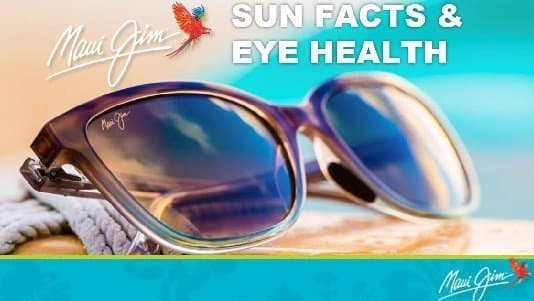
Solar ultraviolet A (UVA), UVB, and HEV (high energy visible, aka harmful blue) rays have been linked to eyelid cancers (basal and squamous cell and melanomas), cataracts, macular degeneration, pigmented spots and dozens of other ophthalmic conditions. Premature aging affects skin crow’s feet, seborrheic keratoses (raised benign lesions), freckles, conjunctival (eye surface) benign growths, cancers, photokeratitis, or sunburned cornea (e.g. snow blindness). 2 out of 3 Australians will be diagnosed with skin cancer by the time they are 70-80% of newly diagnosed cancer is skin cancer.
Maui Jim Sunglasses features means they can be worn all year round !
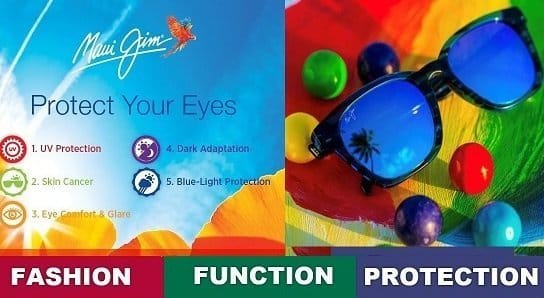
The original Sid, the Seagull Cancer Council message, imploring us to not only slip on a shirt, slop on the sunscreen and slap on a hat, now includes seeking some shade and last but not least to slide on the sunnies.
Indeed the standard recommendation is five forms of sun protection; sunscreen, clothing, hats, shade and sunglasses.
And Sid should say every day you’re at risk of sunburn.


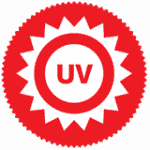


- Weight
- Impact Resistance
- Skin cancer
- Eye comfort
- Lens Clarity
- Scratch Resistance
- Polarization
- UV/HEV Protection
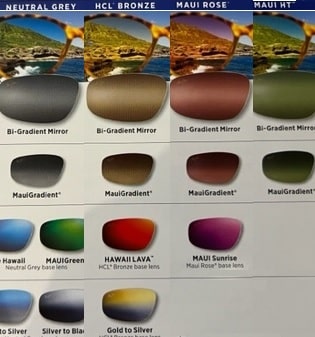
UV damage to the eyes can’t be reversed and is cumulative. Children are more vulnerable to UV exposure than adults. Did you know that a staggering 76% of Australians think wearing sunglasses in winter is unnecessary?
UVA remains constant throughout the year so prevention is key to avoiding long term eye damage.
The sun is lower on the horizon in autumn, winter and spring, so we get more damaging UV directly entering the eye from the back surfaces if glasses are worn.The UV exposure risk for cataract and skin cancer, especially in Australia, is the same all year round, so you still need to wear them on a cloudy day.
MAUI JIM SUNGLASS LENS TREATMENTS allow for the differences in colour clarity and detail.

TOP ROW FINISHES : Neutral Grey Bi-Gradient mirror-Rose Bi-Gradient mirror-Bronze (HCL)- Bi-Gradient mirror-HT-Bi-Gradient mirror- Grey MauiGradient (non-mirror)
BOTTOM ROW FINISHES: Blue Hawaii Mirror, HAWAII LAVA Mirror, Maui Green Mirror, Maui Sunrise Mirror-Dual Mirrors: Dual Mirror Blue to Silver and Silver to Black and Gold to Silver
Please note Dual Mirrors are Not available in Rx.
The Bi Grad mirror is more popular than the non-mirror single gradient. The grey and bronze are more popular than the Rose and the HT.
HT is a High Transmission greenish lens with a bi-gradient mirror (which means the top and bottom has some silver reflective mirror. These lenses are ideal for overcast conditions, bad weather, or any high-intensity sports that require boost and contrast.
MAUIGreen is the newest fashion mirror colour available in SuperThin Glass, MauiBrilliant, and MauiPure LT.
Both Plano and prescription lenses with the MAUIGreen mirror are created using a Neutral Grey base lens enabled with patented PolarizedPlus2
colour-enhancing lens technology. MAUIGreen is a Category 3, which is from 8% to 18% light transmission.
There are four specific front side treatments of specially designed thin layers that alter the way light is transmitted and reflected for various wavelengths. (also three dual mirrors)

We recommend the best prescription polarised sunglasses, which embrace world-leading patented Polarized Plus technology to reduce glare from every angle that reflects any flat, smooth or shiny surface. Construction of these lenses begins with the polarizing filter, which is tinted to the lens colour. This film is placed between two special lenses coated with a scratch-resistant treatment. An anti-reflective coating is applied to the back of the lens. These lenses offer amazing clarity and levels of UV protection, meeting Australian New Zealand standards as special purpose or general purpose sunglasses.
Darkest and best in direct bright sunlight.
Subtle tint,high contrast,fast action activities,birdwatching
Warm tint great for overall conditions
HT (lightest)
Great for low-light occasions and golf




READ MORE ABOUT MIRRORS AND TRANSMISSION OF MAUI JIM SUNGLASSES
The amount of light that transmits through each lens is based on the combination of polarized lens colour and frontside lens treatment. The type of front surface treatment, the colour of the tint and the material determines the parts of the light spectrum that are absorbed by the lenses and transmit to the eye for enhanced colour recognition. Maui Jim PolarizedPlus2 comes in four different polarized colour options. Transmission levels differ with each frontside lens treatment.Bi-Gradient mirror lenses differ in light transmission level by colour. Neutral Grey is the darkest or lowest transmission, and Maui HT the lightest or highest transmission. But no matter what lens colour you select, all Maui Jim lenses offer complete protection from the harmful aspects of UV and HEV. MauiGradient lenses are all very similar in transmission.
HAWAII LAVA is a solid red mirror on an HCL Bronze polarized lens. HAWAII LAVA has a transmission that’s slightly darker than HCL Bronze.Blue Hawaii can be found with two transmission levels. It’s the darkest of the solid mirrors on our Neutral Grey polarized lens in specific styles, but it’s also available in a higher transmission option in other types, including the pure titanium frames.
MAUI Sunrise is a solid mirror on the Maui Rose polarized lens. MAUI Sunrise has slightly higher transmission than the darker Blue Hawaii. MAUIGreenis a solid mirror on the Neutral Grey polarised lens.
MAUIGreen has a similar transmission level to MAUI Sunrise.
Dual Mirrored lenses have two unique gradient mirror colours and have a slightly higher transmission level than MAUI Sunrise. Available on Neutral Grey and HCL Bronze polarized lenses. Two-tone mirror coating is applied to the frontside surface of the PolarizedPlus2 HCL Bronze lens(for the gold to silver mirror) and the Neutral Grey lens (for the blue to silver and silver to black mirrors). Not yet available in prescription.
Full fashion mirrors: All fashion mirror and NEW dual mirror options offer the same colour enhancement, clarity, and protection as all other Maui Jim lenses.
Blue Hawaii – A blue mirror coating is applied to the frontside surface of the PolarizePlus2 Neutral Grey lens. It is now available in prescription.
MAUI Sunrise – A pink mirror coating is applied to the frontside surface of the PolarizedPlus2 Maui Rose lens. It is now available in prescription.
MAUIGreen – A green mirror coating is applied to the frontside surface of the PolarizedPlus2 Neutral Grey lens. It is not yet available in prescription.
HAWAII LAVA – A red mirror coating is applied to the frontside surface of the PolarizedPlus2 HCL Bronze lens. It is available in prescription.
Compare them to your Ray-Ban or favourite pair of designer sunnies such Quay and Co, and the critical difference is the fantastic Maui material that features optics of colour enhancement clarity and detail. Direct sunlight only partly contributes to ambient UV. Under average conditions, more than 50% of ocular exposure comes from scattering and reflection from clouds and the ground.
A polarising layer can “peel” from a lens material. These have the highest quality polarizing film, which is sandwiched in the centre of the lens material itself. Consequently, this avoids any risk of the layer peeling or wearing off.
Five distinct advanced lens materials in sunglass styles, options and lenses to fit your needs.

Options include special-purpose polarized rimless styles with optics nearly as clear as the best optical glass lenses but without the weight or those with the best impact resistance. Polycarbonate is injection moulded and offers the most shatter resistance possible.
WHAT IS THE ABBE NUMBER AND DISPERSION ? WHY IS IT IMPORTANT ?
In optics and lens design, the Abbe number is a complex formula also known as the V-number or constringence of a transparent material, which serves to measure the material’s dispersion (change of refractive index versus wavelength), with high values of V indicating low dispersion. It is named after Ernst Abbe, the German physicist who defined it. The separation of visible light into its different colours is known as dispersion. Maui Jim lenses have wonderful colour rendition optimised for the human eye. The ABBE value = Clarity of the lens material. The higher the ABBE value, the clearer the lens. Weight is listed by specific gravity. A rainbow is produced by dispersion and internal reflection of light in water droplets in the atmosphere. White light from the sun enters a spherical raindrop. The different colours are refracted through different angles, reflected off the back of the drop, and then refracted again when they emerge from the drop.
(STG) Super Thin Glass – Provides the absolute crispest optics available 32% thinner and lighter than standard glass, it offers the best scratch and solvent resistance amongst spectacle lens materials
1. Exclusive Technology: Combines the patented Maui Jim
PolarizedPlus colour-enhancing lens technology with proprietary
material design.
2. Clarity: MauiBrilliant has an Abbe value of 56, almost the same
as glass (58). While Polycarbonate has an Abbe value of 30.
3. Lightweight: MauiBrilliant is the most lightweight Rx’able optical
quality lens material ever released, and it’s about 20% lighter than
Polycarbonate.
4. Impact Resistant: MauiBrilliant is just as strong as Polycarbonate
and exceeds all ANSI impact standards to ensure your eyes are protected.
5. Solvent & Scratch Resistant: Standard optical lens cleaners
can be used on MauiBrilliant while Polycarbonate often can be
damaged by solvents.
6. Reduced Stress: MauiBrilliant shows no stress in frames or
at drill points and therefore is Maui Jim’s preferred material for
drill mounts.
7. Availability: MauiBrilliant is available in plano and prescription
and all frontside lens treatments; it’s also compatible with any
frame material. Polycarbonate is only available in bi-gradient and
is not recommended for drill mounts or Acetate frames.
8. Customer Satisfaction: MauiBrilliant’s versatility, reliability,
and availability adds quality, accuracy, and speed to Maui Jim
prescription sunglass orders. Maui Jim has minimal returns due
to scratches and coating issues
Pure optics almost per STG glass and safer with impact and most popular plano lens
Lightweight,solvent,scratch,impact resistant
Impact resistant and light weight
Read More Features Of Maui Jim Lenses
Of all well known dedicated premium sunglasses including Bolle,JAG, Mako,Oakley, Ray Ban, Rudy Project,Wiley X- Maui Jim sunglasses offer some distinguishing features.
| Material and Code | Abbe Value | Weight (specific gravity) | Impact resistance | Scratch resistance | Available in Rx |
| Superthin Glass STG | 58 | 2.54 | ** | *** | No |
| Brilliant MB | 56 | 1.00 | *** | *** | Yes |
| Pure MP | 52 | 1.02 | *** | *** | No |
| Evolution ME | 43 | 1.31 | *** | *** | Yes |
| Polycarbonate PC | 30 | 1.19 | ** | ** | Yes |
Maui Jim lens colours and transmission
Full Mirror,gradient mirror and non mirror gradient lens options with Maui lens materials
| Maui Evolution | Rx | Plano |
| BiGradient | Yes | No |
| Maui Gradient | Yes | No |
| Blue Hawaii | No | No |
| Maui Sunrise | No | No |
| Maui Polycarboante | Rx | Plano |
| Bi Gradient | Yes | No |
| Maui Gradient | No | No |
| Blue Hawaii | No | No |
| Maui Sunrise | No | No |
| STG Glass | Rx | Plano |
| Bi Gradient | No | Yes |
| Maui Gradient | No | Yes |
| Blue Hawaii | No | Yes |
| Maui Sunrise | No | No |
| Maui Brilliant | Rx | Plano |
| Bi Gradient | Yes | Yes |
| Maui Gradient | Yes | Yes |
| Blue Hawaii | Yes | Yes |
| Maui Sunrise | Yes | Yes |
| Maui Pure | Rx | Plano |
| Bi Gradient | No | Yes |
| Maui Gradient | No | Yes |
| Blue Hawaii | No | Yes |
| Maui Sunrise | No | Yes |

Investing in a pair of Maui Jims allows you to enjoy the famous lens technology and lenses – consumer loyalty is over 90%, which is unrivalled in the industry, and you even can have a risk free prescription sunglasses trial in single vision or multifocal.
Maui lens transmission, antireflection coatings,mirror coatings
READ More on Sunglass classification and antireflection coatings
As light passes through a spectacle lens, a percentage of it is reflected back from the surface of the lens, rather than being passed through the lens. With standard spectacle lenses this represent about 8% of light that is reflected back. Light can also be reflected off the back surface of lenses, especially in situations under overhead fluorescent lighting or driving at night with other car’s headlights. These reflections cause glare, which is uncomfortable, and reduce the contrast of what you are looking at, making objects less easy to see. Multicoat lenses are made up of layers of mineral coating. To minimise reflections over the whole of the visual spectrum, a sequence of layers for different wavelengths is used. To improve the quality of vision, by reducing reflection and increasing transmission, an antireflection coat is always recommended
The Maui Rose lens is the highest contrast lens. This is due to the colour itself, not a “coating”. The rose colour provides the highest contrast, with the HCL Bronze next in line. Each lens colour has its qualities to appeal to many different situations, be they high contrast needs.
Gold or silver is referring to a mirror that is applied as part of the lens process. That mirror colour helps to accent the lens colour.
The most popular lenses are the Neutral Grey and HCL Bronze in the Bi-Gradient Mirror
Category 2 lenses transmit 18-45%
Category 3 lenses transmit 8-17% visible light
Material Choices for SunRx Lenses:
MauiBrilliant and Polycarbonate lenses
Mirror lenses
These are good for situations that require a reduction in the overall brilliance of light, such as sunlight on snow. They reflect light away from the eye (beyond the standard absorption of a tinted lens) which is ideal for people who are light-sensitive.
Applied to the surface of the lens only, it gives the lens a shiny mirror-like appearance that reflects rays from surfaces such as water, snow and ice.
Different mirror coating tints can have different reflectances.
Mirror coatings employ constructive interference to reflect light away from the eye (beyond the standard absorption of a tinted lens) which is ideal for people who are light-sensitive. The mirror coatings are never on the backside. Mirrors are highly reflective coatings, which would make it difficult to see through the lens.
A mirror is essentially a plate of glass coated with a thin film of metal eg Siver whose conduction electrons prevent some light wavelengths from entering beyond a few atomic layers causing reflectance
Mirror coatings allow full surface reflections (or full white light with no loss to be reflected) 99.9% reflectivity over the visible range (400-700 nm).
The front surface mirror metallic coatings have colour elements for specific colour effects.
Most labs will multicoat the backsurface to stop reflections from the HC reflecting back into the eyes.
If a mirror was on the back you would see reflected images from behind so interfering with vision
Antireflection coatings which cover the visible range (400-700 nm) would have approx. 1.0% reflectivity (0.5% from each surface)
The refractive index of various lens materials will affect how much light is lost to surface reflection.
The density of the mirror coating determines how much light it reflects eg half-silvered mirror coatings have an even coating of reflective particles across the surface of the lens, but the particles are spaced so about half of the light striking the lens surface hits a coating particle and is reflected.
The remaining 50% of visible light striking the lens passes between the reflective particles.
Some of this light is absorbed by the underlying lens tint. The remainder passes through the lens to the eye.
Classification: Sunnies and Fashion Spectacles are categorized based on the amount of light allowed to pass through the lens. This is called the luminous transmittance. eg A lens with a 22% transmittance allows 22% of the light to pass through to the eye. The labeling requirements are based on this transmittance value. Lens category Fashion Spectacles^ or Sunglasses*
| Antireflection coatings which cover the visible range (400-700 nm) would have approx 1.0% reflectivity, (0.5% from each surface) being achieved by destructive interference (allowing more lights to pass through the lens without being reflected) as 8% of light otherwise would have reflected back from front surface 4% and the back surface 4% Depending on the refractive index, transmittance reduces from 92 % with 1.5 index to 88 % with 1.67 index. The back surface anti reflection coating is engineered ( one quarter wavelength thick needs to be deposited on the surface of the lens ) such that reflected light from the coating and lens surfaces interferes destructively, causing less reflection as glare to the eye and more pass-through of the incident light from the object viewed for better contrast. Otherwise as light is reflected from both the front and back surface this causes a reduction in contrast as the transmitted light is reduced, and there are annoying reflections from both surfaces of the lens. As the wavelength of visible light varies from 380nm to over 700nm, it is not possible for one layer to cancel out reflections for the entire visible spectrum. Indeed, the first coatings were single layer aimed at reducing reflections around the centre of the spectrum at around 550nm. This coat stopped yellow/green reflections but allowed considerable reflections of red and blue. This gave the residual colour of amethyst but still allowed reflectance of around 4 per cent. These combinations tend to produce coatings that have a residual minimal reflectance around the green area of the spectrum, which gives them a green hue. More recently, antireflection coatings have been developed to reflect specific parts of the visible light spectrum and to reduce reflection of non-visible wavelengths such as UV. Any colour reduces transmission. Internal reflections are usually associated with thicker lenses and is related to the critical angle that the light inside the lens makes with the back surface. If the light strikes the internal lens surface at an angle greater than the critical angle of the lens material, then total internal reflection will occur and the light will be reflected internally at the same angle that it struck the surface. |
Lens colour,material and sunglass category
Category 2 has light transmisssion 18-45% at center of lens versus Category 3 at 8-18%.
99.9% glare reduction,95% of HEV and 100% harmful UV.
| Colour Gradient | STG Glass | Maui Brilliant | Maui Pure | Maui Evolution | Polycarbonate | Mirror Colour |
| Grey Bi-Gradient | Category 3 | Category 3 | Category 3 | Category 3 | Category 3 | Silver |
| Grey MauiGradient | Category 2 | Category 3 | Category 3 | Category 3 | n/a | n/a |
| HCL Bronze Bi-Gradient | Category 3 | Category 3 | Category 3 | Category 3 | Category 3 | Gold |
| HCL Bronze MauiGradient | Category 2 | Category 3 | Category 3 | Category 3 | n/a | n/a |
| Maui Rose Bi-Gradient | Category 3 | Category 3 | Category 3 | Category 3 | Category 3 | Silver |
| Maui Rose MauiGradient | Category 2 | Category 3 | Category 3 | Category 3 | n/a | n/a |
| Maui HT Bi-Gradient | Category 2 | Category 2 | Category 2 | Category 2 | Category 2 | Gold |
| Maui HT MauiGradient | Category 2 | Category 3 | Category 3 | Category 3 | n/a | n/a |
| Blue Hawaii BH | Category 3 | Category 3 | Category 3 | n/a | n/a | Blue |
| Maui Sunrise PS | Category 3 | Category 3 | Category 3 | n/a | n/a | Pink |
| Maui Green | Category 3 | n/a | n/a | n/a | n/a | Green |
| Dual Mirror | Category 3 | n/a | n/a | n/a | n/a | Gold to Silver |
| Dual Mirror | Category 3 | n/a | n/a | n/a | n/a | Blue to Silver |
| Dual Mirror | Category 3 | n/a | n/a | n/a | n/a | Silver to Black |
There are variations in light transmissions due to colour and material and not only just front surface treatments. The higher the light transmission, the “lighter” the lens. Colourimetry studies have shown the importance of colour.
Maui Jim materials block UV to 400nm including glass. Generally tints do play a role and can block a good amount of UV above 380nm. It is measurable using a simple UV meter. Maui Jim uses UV inhibitors in their glass which does add some colour to the front wafer.
MauiPassport

MauiPassport is Maui Jim technology in prescription. 100% digitally processed lens, with optically corrected and wrap compensated technology.The compensated technology is placed on the back of the lens for a wider field of view.Optically corrected and wrap balanced lens design.
Single Vision and Progressive lens styles.
• MauiBrilliant, Maui Evolution and Polycarbonate. (Polycarbonate is not recommended for drill mounted prescription lenses.)
• Neutral Grey, Maui Rose, HCL Bronze, and Maui HT.
• Bi-Gradient mirror, MauiGradient, and Blue Hawaii.
• MauiPassport can be used in non-wrap frames also. The wrap corrections are automatically reduced as the frames flatten. All lens materials come with three patented rare earth elements, which are unique to any other material.
• Accurate to within 1/100 of a diopter in Progressive and Single Vision
• Backed by outstanding warranty and service
• Optical perfection – edge to edge for a wider field of view.
• Eliminates the “swim effect.”
• Fits in even the largest Maui Jim frames while retaining the look of plano sunnies.
Maui prescription materials and mirrors
Our B2B allows us order prescription details with suitable frames, lens materials and colours.
RX Colours Neutral Grey, Maui Rose,HCL Bronze,Maui HT
In the presence of prism, “white light” is broken up into the familiar rainbow. The higher the index of the material, the more these colours are observed because of the materials Abbe value. There are only four lenses in the entire lens industry with ABBE values over 50.
• Brilliant and Pure lens materials are the lightest lenses ever produced.
MauiGradient non mirror tint
Bi-Gradient Mirror
Blue Hawaii mirror is only available with neutral grey colour
MauiGradient non mirror tint
Bi-Gradient Mirror
Only available with Bi-Gradient Mirror
Protect and preserve the front and back of your eyes.

The light which enters the side of the eye closest to the ears can be internally reflected and come to a focal point on the side of the eye closest to the nose. This can cause pterygium. Pinguecula and pterygium are two common growths on the whites of the eyes, usually, the nasal side where the thin clear protective tissue becomes thickened, fleshy and raised. They are best observed through a slit lamp microscope. If there is extraordinary evidence of invasion, extension, or vascularity, carcinoma can be considered but typically are benign. A Pinguecula is a more yellowish deposit of protein, fat, or calcium that can remain small or develop the wing-like extension of pterygia with some redness and swelling with gritty symptoms. They can be removed by surgery or laser resurfacing if required (generally if encroaching enough to affect vision) but are best prevented by avoiding cumulative UV exposure, wind, dust. Careful selection of coated wrap sunglasses ( close-fitting, wraparound pair or classic style with thick arms can help prevent glare and damaging rays from coming in the sides, as can the best sunglass lens technology and lubricants can reduce their incidence. Whilst pterygia themselves are not cancerous, they are associated with higher skin cancer risk.
Maui Frame types and options

We can provide parts and service and replacement lenses. The model name e.g. Maui Jim breakwall polarised with the maui lens type are required. Patent number location and Lens Type/Material codes will appear on the left temple as does patent number. SKU numbers can be seen on the right temple:
First three numbers: Style Last numbers/letters: Frame colour
Example: 202 – 2M: Peahi frame in Matte Black frame colour. Lens colours are not listed on the frame. 4 styles compatible with Clip-Ons. Clip-Ons are a MauiPure Bi-Gradient sun lens and come in 4 different colours.
Let us help you benefit by the right custom material for your specific activity :
Custom materials for different activities
2. What type of activities do you engage in outdoors? How often?
3. While you are outdoors, describe how glare affects you:
4. Do you protect yourself from the rays of the sun and UV light?
5. What do you believe is the most damaging effect of UV on the eyes?
6. Do you own a pair of sunnies ? Please tell me about them:
What are Dual Mirror lens colours?
Mirror coats are metallic. The thickness determines how dark they are. Gradient mirrors just have a wedge shaped cross section to the coating. It’s typically just chromium of different thicknesses. A thin layer is silver and as it gets thicker it turns gold. Different metals are employed in a vacuum deposition process. The Dual Mirror lens colours are the latest PolarizedPlus2 fashion lens offering with a two-tone mirror (STG)
The Gold to White Dual Mirror is delivered via the HCL Bronze base lens, and the Blue to Silver and Silver to
Black Dual Mirrors are both available in Neutral Grey base lens.
Blue to Silver over the Neutral Grey base lens
Silver to Black over the Neutral Grey base lens
Gold to Whitish/Silver over the HCL Bronze base lens
Available one style : Kami (STG ) Green Mirror Coating
Gray is recommended as a “all purpose” polarised lens. Brown provides improved contrast and depth perception. A good choice for shallow water fishing. Best choice for drivers who want sharpened contrast for “reading the road”. Fashion authorities believe brown is a more flattering colour on the face.
Bi-Gradient lens is a different lens to the Evolution Maui HT MauiGradient. They are not just the same base lens with either the Bi-Grad mirror or MauiGradient Tint applied. The MauiGradient Tint is in-built in the lens itself. Bi-Gradient lenses generally transmit less light than the single non mirrored Maui-Gradient lenses, but this can vary particularly with the MauiHT lenses. The Neutral Grey Bi-Gradient Mirror is darker than the Neutral Grey Maui Gradient tint. However, the Maui HT (Green) Bi-Gradient Mirror is lighter than the Maui HT (Green) Maui Gradient tint.
The most popular transparent spectacle lens material is CR-39 and does not entirely block the most plentiful source of UVR – the solar spectrum between 350 and 400nm.
UV absorbers send CR quite yellow, so they are often only used with a tint for sunnies. The yellow factor plays a role in the colour of all the hi-index except polycarbonate. Most glass lenses need a tint to get close to 100% and do not block any UVA, and only some UVB – UVC doesn’t hit the earth as it is luckily absorbed in the upper atmosphere.
Let us help you choose your plano pair from many great fashion styles or choose your prescription sunglasses pair.
Polarized rimless styles,Classic Styles,Fashion Styles,Cat Eye,Wrap,Rectangular,Aviator,Shield.
Frame choices Metal,Monel,Stainless Steel,Titanium,Magnesium.
Hexetate newest ophthalmic frame material from Maui Jim. Hexetate combines the beauty and colour richness captured in acetate in a final product that is lighter and more flexible than acetate frames similar in size.
Top features and benefits of Hexetate material include:
• Lighter than Acetate. 10% lighter with the same thickness but stronger and more flexible.
• A more rigid surface can withstand scratches better than acetate.
• Once adjusted, Hexetate has excellent shape memory.
• Phthalates FREE (BPA and DEP free).
Specialty materials include Grilamid Front with Thin Metal Temples, Acetate front with etched Titanium temples,Stainless Punchout with Memory Metal,Maui Flex ( memory Beta Titanium)
Plastic,Cellulose Propionate,Nylon,Grilamid,Acetate
You can even choose your custom pair in Plano via the My Maui system, including adding a bifocal segment.
My Maui readers are always Plano with a +1.5 +2.00 +2.50 available in the standard four colours and four mirrors and Blue Hawaii, Blue to Silver, Gold to Silver, Silver to Black mirrors.Seg height is always datum less 6mm in these cases.
We offer a full repair service as a select stockist of the optical range and over 50 different sunglass models with all lenses covered.We have full access to a vast array of hundreds of lens tint colours and materials. With or without your prescription.We can quickly filter through all the frame and lens options for men, women and children of all face shapes. The TAIL SLIDE model is just one of the Classic Polarised styles, as is the HO’OKIPA Polarized Rimless style, where gloss black, smoke grey or tortoise frame colours complement lens finishes and material options.
If you need special solution we can assist to find the perfect special purpose cycling or motorcycle sunglasses to suit your helmut and requirements.
Clear polarised lenses are not possible and the benefit of the protective tint say for motorcycle glasses with maui jim lenses clarity as all other maui options has to be experienced to be appreciated.
Polarizing light is only possible when the film has some colour. As a result, clear polarized lenses are not possible. The darker the colour, the greater the polarizing effect.Polarised lens colours can be used to provide an accent to fashion frames, match a patient’s hair colour or favorite outfit.
Polarised lenses can be tinted. Lighter colours work best for tinting. The wide assortment of polarized colours available allows dispensers to create custom colours that they were not able to achieve in the past.
eg Brown polarising for fresh water fishing , grey polarising for saltwater / blue water fishing. For technical activities such as clay pigeon shooting we would HT (High Transmission) lens, in Maui Brilliant or Maui Pure.
We recommend HT Brilliant for shooting. Higher impact resistance than glass and similar clarity.
HCL Bronze is best for driving, as it caters for all conditions.
HT is the best lens for early morning and late afternoon. Also best for overcast conditions.
The best frame material is dependent on the style, prescription or non-prescription lenses and will vary with the newest releases
Optical clarity,Scratch resistance,Weight,Impact Resistance are all important factors.
The majority of Maui frames come in a gloss finish rather than matt unless otherwise stated. eg black frame colour as gloss black or matt black.
Parameters: Sunglass Frames (+3.00 to -6.50)
Guidelines: Ophthalmic Frames (+4.00 to -11.00)
Maui Jim prescription sunglasses Australia can boast 95% of all Maui Jim Sunglasses are available also in your prescription
The Maui Jim Ho’okipa model is but one of the popular polarized rimless sunglasses.
Overall the sales mix would be:
Bi-gradient to Maui Gradient 50:50
Lens colour Grey 50+ / HCL Bronze 40 / Rose 5 / HT <5
It depends on many factors such as type (RX or Plano), style (male vs female), and price point.e.g. Blue Hawaii is only available in Plano at present
|
|
Maui Jim clear lenses
Did you know Maui Jim Optical have created a proprietary clear lens, designed specifically to protect you against High Energy Visible (HEV) Light, often referred to as “harmful blue light”.
PROPRIETARY TECHNOLOGY
• Virtually clear with no blue or yellow tint
• Blue Light / HEV filter layered inside lens material (not a coating) which won’t wear off over time.
• Blocks harmful blue light while allowing beneficial blue light to pass through for improved contrast and resolution
• In addition to balanced blue light management, includes premium front and backside anti-reflective coating for improved vision and Clearshell scratch protection.
The Maui High Contrast Lens counters the aging of a person’s crystalline lens by reducing yellow light transmission by 55% at 585nm while transmitting 90% of the primary colours of vision.
Maui repair and warranty
Trade-In your Maui Jim frames
Sunglass returns should be in their original case, and frames/lenses should not be damaged (i.e. large scratches, cracked/chipped lenses).
Maui Jim is famous for its ” Aloha Spirit” customer service, and its production facilities provide very high state of the art recycling.
The Maui evolution continues with new lenses such as dual mirror finishes and even in the optical frame range. Ophthalmic Frame 2-year manufacturer’s defect warranty applies.
Many materials can be recycled, so it’s good for the earth and good for your eyes.
If you are currently wearing Rx Maui sunnies and your prescription changes, we can update the lenses into a new frame of the SAME model, with no charge for the frame, only the lens cost. Warranty policy and repairs are simple; it works as customers from over 128 countries can attest there are no sunglasses like these sunglasses, so your frames and lens are covered accordingly.
Read more about upgrading to Maui Jim Sunglasses
Warranty applies to the original purchaser for two full years from the date of purchase against any defect in materials and workmanship when purchased from an authorized reseller.
Should you have worn Plano i.e. non-rx, and now require Rx, we can supply a new version of that frame fitted with the Rx lenses, but the only cost is the lens cost only to have your sunnies with new lenses. Spare parts on all models and genuine quality sunglass replacement lenses are available with fast turnaround, free shipping and postage.
There are no sunglasses quite like them, and many customers keep their favourite brand type for their particular outdoor requirement.
Maui Jim’s mission to help customers means a sunglass fix is simple, whether upgrading their sunglasses with new lenses. Hence, customers keep their favourite frames or replacements can be found for their original lenses.
Should you wish to replace your Plano lenses, RRP $ 135 fitted by us or at Maui Jim major repair centre, assuming it’s not discontinued on the website.
Should a prescription be required to a discontinued frame, sometimes this can be accessed.
Rx replacement lenses can vary as per Rx price list under lens only, but the beauty and value of Maui Jim are that the frame that the lenses are fitted into is replaced at no charge. ( so no timeframe for RX charge lenses only and free frame replacement.
The only time we can substitute a different model frame is if the new Rx is no longer within range or the frame model is discontinued, as we then can replace another style of the frame at no charge.
In such cases, after the new order is delivered, credit for the frame price occurs as your existing frame is returned to them.
A particular form must order these trade-ins, not via a website, and when ordering, we indicate we intend to send the trade in the frame, but it does not need to be shipped until the new pair is collected.
HOW TO CLEAN SUNGLASSES
For optimum performance, rinse your sunglasses daily in warm water. Use a mild liquid dish or bath soap to wash each lens surface—dry using a clean, soft, absorbent cloth. Ideally, use peeps to clean your lenses rather than soaps or detergent.
Certain common household chemicals will react negatively with the frame material and the metal oxides used on the coatings of your lenses. Avoid contact with acetone, glass or other ammonia-based cleaners, hair sprays, chlorine or glue.
“Hard” water and saltwater contains high levels of dissolved minerals, which can leave white spots on lenses after drying if filtered (tap) water is used to rinse.
Excessive heat may deteriorate your lenses or misshape your nylon frame. Avoid placing your sunglasses where you might expect excessive heat, for example, on the dashboard of your car. Such measures are simple, works save money and are good to take special care of your favourite Maui Jim model- hotly debated as 1000,000’s of customers- keep their favourite for specific activities -prioritise when not wearing them to store them in their case. As well as the famous colour, clarity and detailed description, Maui Jim innovates and sets the standard.
